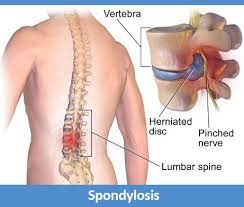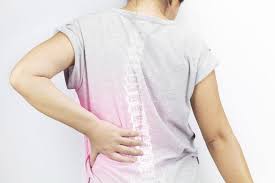What is
Spondylosis (Degenerative Disc Disease)
Degenerative Disc Disease (DDD), also known as Spondylosis, is a condition that usually occurs due to aging. As the term implies, it is the progressive deterioration of the discs between the vertebral bodies. Spondylosis (a different term than spondylolisthesis) is typically a degenerative condition of the joints of the spine and is also known as spinal osteoarthritis. The discs, joints and ligaments of the spine are generally involved. The discs lose their cushioning effect between the spinal bones, the ligaments become weaker or thicken, and the bones can develop bony growths or spurs. Aging and repetitive stresses to the spine are the primary causes of this degeneration, but it also can be present in younger adults who have had prior trauma. Not everyone will have symptoms (usually pain) as a result of spondylosis. If severe, spondylosis may cause pressure on nerve roots with subsequent pain or tingling in the arms or legs.

What are the Symptoms of Degenerative Disc Disease?
Not everyone will have symptoms (usually pain) as a result of spondylosis. If severe, spondylosis may cause pressure on nerve roots with subsequent pain or tingling in the arms or legs. The most common clinical manifestation of a degenerative disc disease is lower back pain that may or may not radiate to the upper part of the thighs. Some individuals who experience pain from Spondylosis describe morning pain as lower back stiffness or rigidity.
In some individuals, the vertebra loses flexibility. Others experience bone spurs or disc bulging that can compress a nerve root, which can cause chronic pain, numbness, and weakness in certain body parts. This condition, however, can occur anywhere along the spinal column, with most cases occurring at the cervical region (degenerative disc disease of the neck) and at the lumbar area (lower back).
How Do You Describe Spondylosis (DDD)?
Spondylosis is typically a degenerative condition of spinal joints and is also known as spinal osteoarthritis. Discs, joints and ligaments are usually involved. Discs lose their cushioning effect, ligaments become weaker or thicken, and vertebrae can develop bony growths or spurs.
How Does Spondylosis Occur?
With aging, the shock-absorbing cushions termed as intervertebral discs, loses fluid resulting to a decreased flexibility of the spine, bulging, thinning, and lesser cushioning ability of the discs. Aside from the normal wear and tear as individual ages, degenerative disc disease can also occur due to injury as a result of an external trauma or repetitive stress on the vertebra. Other common factors that can contribute to advancement of disc degeneration include obesity, smoking, and genetic factors.
How do you Screen and Diagnose Degenerative Disc Disease (Spondylosis)?

Your doctor will first perform a physical exam to observe your posture, range of motion and physical condition, noting any movement that causes you pain. A neurological exam may also be performed to test your reflexes and muscle strength. This evaluation also checks out other symptoms, such as numbness, tingling, or bowel and/or bladder problems. As your doctor develops the diagnosis, imaging tests may be performed. These may include X-rays, CT or MRI. An MRI is especially good at showing abnormal discs, ligaments or nerve roots. CT scans can show inflammation of the facet joints, which could indicate spondylosis. With an X-ray, your doctor will be able to see the bony elements of your spine.
Non-surgical treatments for spondylosis include epidural injections, chiropractic care, pain management medications and physical therapy. If the pain continues or there is evidence of a severely compressed nerve, surgery may be considered. Surgery for spondylosis involves two main components: eliminating what is causing pain and then fusing the spine to control movement. Surgery may also include decompression, which means removing the tissue that is pressing on nerves. Spondylosis and disc degeneration causing functionally disabling pain that fails to improve with conservative treatment may be treated with fusion or disc replacement surgery. Every case is different It is therefore very important to discuss treatment options with a spine specialist familiar with all types of spinal surgery in deciding which treatment, if any, may be best for you.
What Are The Treatments for Degenerative Disc Disease (Spondylosis)?

Request An APPOITMENT
Fell free to contact us with any questions or concern regarding Back/Neck pain.